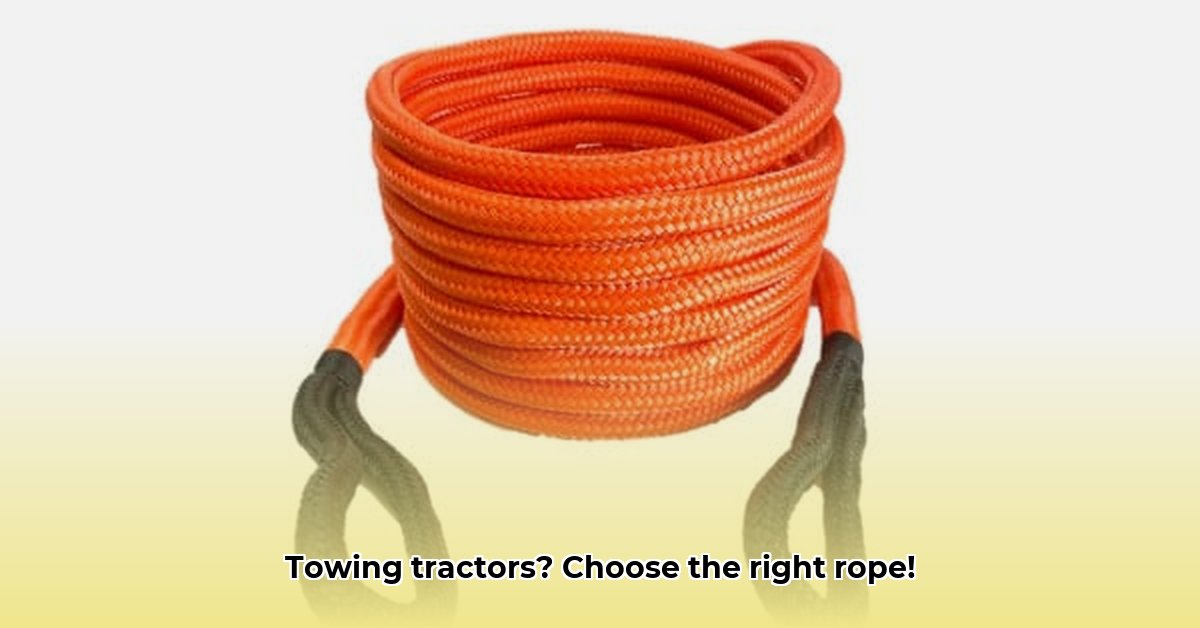
Choosing the right tow rope is crucial for safe and efficient tractor operations. This guide helps farmers and agricultural stakeholders select between nylon and UHMWPE (ultra-high-molecular-weight polyethylene) tow ropes, considering factors like strength, durability, cost, and environmental impact. For more information on choosing the right tow rope for your needs, check out this helpful resource: Tow rope selection guide.
Understanding Your Towing Needs
Before selecting a tow rope, assess your typical towing scenarios. What types of equipment do you usually tow? What are the typical terrains (smooth fields, muddy areas, rocky ground)? How heavy are the loads? Answering these questions helps determine the necessary rope strength and features. For example, frequently towing heavy machinery across rough terrain necessitates a more robust rope than occasional light towing on paved surfaces. Are there any specific regulatory requirements or safety protocols in your region you need to adhere to?
Rope Materials: Nylon vs. UHMWPE
Two primary materials dominate the heavy-duty tow rope market: nylon and UHMWPE. Each offers distinct advantages and disadvantages:
| Feature | Nylon | UHMWPE |
|---|---|---|
| Strength | Strong | Super strong |
| Shock Absorption | Good shock absorption | Low shock absorption |
| Weight | Moderately heavy | Lightweight |
| Cost | Lower initial cost | Higher initial cost |
| Stretch | Moderate stretch; good for precise towing | Minimal stretch; better for uneven ground |
| Environmental Impact | Moderate; petroleum-based | Moderate; petroleum-based, but potentially longer lasting |
Rhetorical Question: Given the trade-off between initial cost and long-term durability, how can farmers determine the most cost-effective rope for their specific needs?
Quantifiable Fact: UHMWPE ropes often boast breaking strengths exceeding 30,000 lbs, significantly higher than many nylon alternatives.
Nylon's shock absorption protects equipment from sudden jerks, making it suitable for various tasks. UHMWPE, while less forgiving of impacts, offers superior strength and minimal stretch, ideal for controlled pulls on smoother surfaces.
Choosing the Right Rope: A Step-by-Step Guide
Follow these steps to select the appropriate tow rope:
- Assess Towing Needs: Analyze the typical weight and type of equipment towed, the terrain conditions, and the frequency of towing operations.
- Material Selection: Based on step 1, choose nylon for shock absorption or UHMWPE for superior strength.
- Determine Required Strength: Select a rope with a breaking strength significantly exceeding the heaviest load anticipated. A safety factor of at least 5:1 is recommended.
- Choose Appropriate Length: Select a length providing sufficient reach without excessive slack or potential tangles.
- Regular Inspections: Before each use, carefully inspect the rope for wear, fraying, or damage. Replace immediately if any damage is found.
- Proper Storage: Store the rope properly, away from direct sunlight and moisture, to maximize its lifespan.
Expert Quote: "Regular inspection is paramount. A seemingly minor flaw can lead to catastrophic failure under stress," states Dr. Emily Carter, Agricultural Engineering Professor at the University of California, Davis.
Safety Considerations
Safe tow rope usage is non-negotiable. Always:
- Inspect the rope thoroughly before each use.
- Never exceed the rope's working load limit (WLL).
- Wear heavy-duty gloves when handling the rope.
- Maintain clear communication between tractor operator and the person guiding the towed equipment.
- Adhere to all manufacturer safety guidelines and instructions.
Environmental Impact
Both nylon and UHMWPE ropes are petroleum-based. However, UHMWPE's superior durability often leads to a longer lifespan, reducing the frequency of rope replacement and minimizing waste. Responsible disposal practices for both rope types are crucial for minimizing environmental impact.
Key Takeaways:
- The right tow rope enhances farm efficiency and safety.
- Nylon offers a cost-effective solution for lighter-duty tasks.
- UHMWPE excels in heavy-duty applications where durability is critical.
- Sustainability favors UHMWPE’s longer lifespan, reducing waste.
- Thorough needs assessment ensures optimal rope selection.